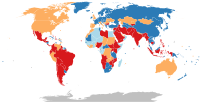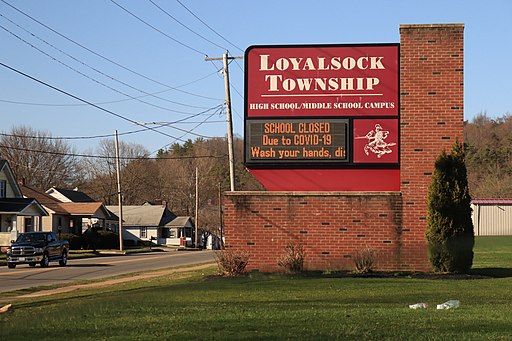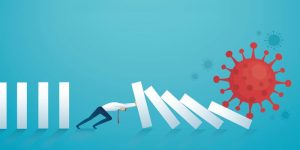12 COVID-19’s Effect on Higher Education and What is Being Done
Jack Klinge
Introduction

Since the beginning of the 2020 COVID-19 pandemic, the global population has been going through a whirlpool of side effects. This chapter will discuss major challenges facing the college education system of the United States and the start of global school closures. COVID-19 has greatly impacted the industry of college education. More specifically, engagement, interaction, and communication between college students and their peers have been changed, improved, and altered in response to the pandemic. It’s pertinent throughout this discussion to include not only the impacts of COVID-19 on the college education system, but also to mention many of the adaptations and solutions that are being provided in response to the abnormal hindrances to education during the pandemic. How these alterations relate to the studies of science, technology, and society (STS), how they create major differentiations in the outcomes of college students’ futures and the connection between these alterations to the STS paradigm of path dependency will also be discussed. The importance of this topic has led to reform and deeper consideration of the system of higher education. The topic has also been the main focus of headlines around the world because education is the foundation for many countries, governments, and economies.
COVID-19’s Impacts on Education
To begin, the impacts of COVID-19 on higher education are many, but the most important ones fall between two categories: physical (or structural) and psychological (people). These two categories are relevant because higher education can be described in two separate entities. The physical or structural is the location that teaching takes place and how teaching is organized and provided. The psychological or people are the individual who are involved in running that system and learning from it (ie. teachers and students). Now that some background information has been laid out, the impacts of the pandemic on the structure of higher education and the psychological impacts that COVID-19 is having on people involved in it are more organized and understandable.
– Physical Impacts –

First to be discussed are the physical impacts and how they have affected the structure of learning within the education system. To say that the pandemic has disrupted this structure of learning is an understatement. As of mid-April, according to UNESCO, 1.5 billion students and youth (roughly 87% of the world’s student population) were affected by school closures in 195 countries, from pre-primary to higher education (Wolkoff). The previously mentioned information is horrifying considering that almost 90% of students were affected by school closure.
On top of schools closing a cause and effect paradigm is also impacting higher education. The pandemic has caused schools to physically close. Those school closures, in turn, are causing the structure of teaching, which have been centered around the physical location of college campuses to collapse. When schools are physically closed the accessibility and reliability of their learning structure is reduced. A crumbling learning structure also affects students and teachers, the people entity of the college education system. Members of this system can’t attend school, give or receive lessons in their academic areas. This physical absence of a learning structure and a formal school setting is a perfect segway into the psychological impacts of the COVID-19 pandemic on students and teachers.
– Psychological –

Everyone who has either heard of, attended, or sent their children off to be educated at college knows about the stress, anxiety, and responsibility that students at higher educational institutions have to deal with and learn to cope in order to excel in their learning. However, there is a limit to the amount of these three variables that an average student can handle. Once those levels are higher than they are supposed to be, they can cause students to do poorly in their school work, not get enough sleep, not eat, have a bad attitude, and not being the best person they can be, etc. A study by doctors and scientists from the Houston Methodist Hospital and the Department of Industrial and Systems Engineering at Texas A&M University discovered that of the 195 students they tested,
“138 (71%) indicated increased stress and anxiety due to the COVID-19 outbreak. Multiple stressors were identified that contributed to the increased levels of stress, anxiety, and depressive thoughts among students. These included fear and worry about their own health and of their loved ones (177/195, 91% reported negative impacts of the pandemic), difficulty in concentrating (173/195, 89%), disruptions to sleeping patterns (168/195, 86%), decreased social interactions due to physical distancing (167/195, 86%), and increased concerns on academic performance (159/195, 82%). To cope with stress and anxiety, participants have sought support from others and helped themselves by adopting either negative or positive coping mechanisms” (Son 21279).
From this study COVID-19 is having a massive psychological impact on students, the people entity of the college education system. Another study on the psychological effects that Coronavirus is having on student also noted, “Due to the long-lasting pandemic situation and onerous measures such as lockdown and stay-at-home orders, the COVID-19 pandemic brings negative impacts on higher education. The findings of our study highlight the urgent need to develop interventions and preventive strategies to address the mental health of college students” (Bilecen).
Adaptive Solutions (Short-Term & Long-Term)

What is being altered, changed, and innovated to combat the negative impacts that the pandemic is having on higher education must also be discussed. It is important to understand that the world, let alone the United States, has never experienced a natural crisis on such a widespread scale. This is mentioned throughout an interview conducted by the Harvard gazette on the former secretary of education for Massachusetts, Paul Reville. Reville, in response to a question about the similarities between today’s pandemic and other historical events, told the journalists, “There were substantial closings in many places during the 1918 Spanish Flu, some as long as four months, but not as widespread as those we’re seeing today. We’re in uncharted territory” (Mineo). However, Reville notes that there are solutions to the problems caused by COVID-19. When asked what can be learned and enacted in response to the pandemic crisis, Reveille points out that he had recently been talking to people in New Hampshire discovered that “because of all the snow days they have in the wintertime, they had already developed a backup online learning system. That made the transition, in this period of school closure, a relatively easy one for them to undertake. They moved seamlessly to online instruction” (Mineo).
New Hampshire’s example is something that the entire world, not just the U.S is trying to implement and take advantage of. This explains the massive amounts of video chat software (Zoom, Google hangouts, Microsoft meetings) that everybody is always hearing about in the news. Many schools have transferred to an online system of learning through these outlets to continue to educate students, offering them the ability to still go to class and learn while staying safe. One personal experience I have is the way Clemson has integrated online instruction into its learning structure. Clemson students can watch and listen to their professors’ lectures for each class through Zoom and other software and continue taking notes and asking questions like they did in their pre-pandemic college academics. Canvas, Clemson’s class work interface has also been a massive help during times where in-person questions and handouts cannot be applied. All the work for each of my classes appears in organized online spaces, where I can find recordings of teachers’ lectures, their lecture notes, and practice problems.
Other types of solutions to the impacts of the pandemic on the education system include correspondence schools, where the vast majority of interaction happening by email. Another solution is directing students to online tutoring and practice programs, and posting videos for them (Harris). The way that Clemson has responded to the pandemic, in my opinion, is superior to the other solutions mentioned. How higher education can better prepare for pandemics is a topic that is now widely being discussed. One example of this discussion is a realization that higher education institutions need to invest in high-quality educator preparation, with the inclusion of teacher and leader residencies in high-need communities. A research article by Darling-Hammond presents major suggestions on how contemporary pandemic societies can build stronger higher education. It notes that:
“High-quality programs begin with strong, research-aligned standards for teaching and school leadership, long-recognized as a foundation of high-achieving education systems and as a key feature for influencing preparation programs quality and supporting student learning. Policymakers can update and strengthen these standards to reflect the needs of today’s students – including new knowledge about social, emotional, and cognitive development; culturally responsive pedagogies; and trauma-informed practices and then ensure that these standards are reflected in licensure requirements, performance assessments for teacher and administrator candidates, and performance-based accreditation for programs (Darling-Hammond & Hyler).”
Relevance to STS Theory
Existing solutions are not perfect. A representative from the Brown Center on Education Policy explains that,
“Families will get more accustomed to online learning. However, this approach has the significant disadvantage that families have to play the role of hall monitor and teacher. Few families want or can afford that, given their work schedules and other responsibilities. Moreover, research consistently suggests that students learn less in fully virtual environments (Harris).
This is where STS, particularly its emphasis on understanding how new technology affects society comes into play. This emphasis can help create guidelines on which approach we should take to deal with the COVID-19 crisis. STS calls for us to question many of the innovations and solutions being provided during this troubling time, especially in education. This perspective is important in fixing the education system during the pandemic because the only way to escape the problems COVID-19 has caused is through technological and scientific learning. Integrating perspectives from STS with the development new technologies and strategies for dealing with the COVID-19 pandemic is important and helps us to come up with efficient, productive, and accessible solutions for the problems of today.
In terms of theory, changes to the physical education system brought about by COVID-19 and the psychological impact that it has had on those involved in the system reflect the STS paradigm of Path-Dependency. Put simply, Path-Dependency argues that future outcomes will shaped by what has happened in the past. For higher education the effects of the past are the psychological and physical changes it has experienced. By disrupting the higher education system that existed prior it, the pandemic will change our society in the future in unpredictable ways, possibly having economic or political impacts.
Conclusion
The structure of higher education between schools is different, and the psychological impact that COVID-19 is having may vary from one student to the next. However, it’s important to note that a majority of students and educational systems will experience a variety of everlasting effects that are similar, even if the impact of these effects might vary between schools. The COVID-19 pandemic and the public response to it will go down in history as a unique event because nothing like it has happened on such a global scale in the past. Neither has any previous event had such as an impact on higher education, if not all education as the Coronavirus. The pandemic in the short term has created chaos among many educational institutions. While solutions and patchwork fixes have been created to slow the massive implications caused by the pandemic, the permanent physical and psychological effects of COVID-19 on the educational systems is still unknown. Only with the passage of time will society fully understand the total disarray that the pandemic has left on education.
References
Bilecen, Basak. “Commentary: COVID‐19 Pandemic and Higher Education: International Mobility and Students’ Social Protection.” International Migration, vol. 58, no. 4, 2020, pp. 263–66, https://onlinelibrary.wiley.com/doi/full/10.1111/imig.12749.
Darling-Hammond, Linda, and Maria E. Hyler. “Preparing Educators for the Time of COVID . and Beyond.” European Journal of Teacher Education, vol. 43, no. 4, 2020, pp. 457-465, https://www.tandfonline.com/doi/full/10.1080/02619768.2020.1816961
Harris, D. N. “How will COVID-19 change our schools in the long run?” Brookings, 24 Apr. 2020, https://www.brookings.edu/brown-center-chalkboard/2020/04/24/how-will-covid-19-change-our-schools-in-the-long-run/.
Mineo, Liz. “Time to fix American education with race-for-space resolve.” The Harvard Gazette, 10 Apr. 2020, https://news.harvard.edu/gazette/story/2020/04/the-pandemics-impact-on-education/.
Wolkoff, Melanie. “Education reinvented: How COVID-19 has changed how students learn.” ZDNet, 24 Jul. 2020, https://www.zdnet.com/article/education-reinvented-how-covid-19-has-changed-how-students-learn/.
Son, Changwon et al. “Effects of COVID-19 on College Students’ Mental Health in the United States: Interview Survey Study.” Journal of Medical Internet Research, vol. 22, no. 9, 2020, pp. 21279, https://www.jmir.org/2020/9/e21279/.
Images
“COVID-19 school closures” by betseg is in the Public Domain
“School Closures – Covid” by Wikimedia Commons is licensed under CC BY-SA 4.0
“COVID Domino Effect” by Santima.Studio is in the Public Domain
“Online, Education, E-learning” by Needpix is in the Public Domain

